Melasphaerula graminea
Melasphaerula graminea (L.f.) Ker Gawl. (= Melasphaerula ramosa (L.) N.E.Br.)
Family: Iridaceae
Common names: fairy bells (Eng.); baardmannetjie, bokbaardjie, feeklokkie (Afr.)
Introduction
This attractive, winter-growing, bulbous plant, with its lax sprays of half-nodding, long lasting, grass-like flowers, is ideal for hanging baskets.
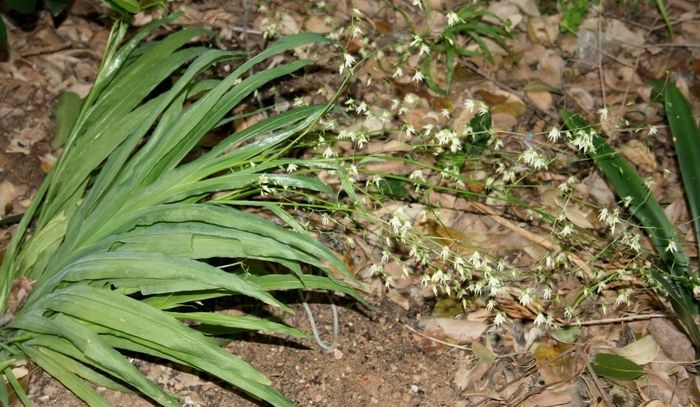
Description
Description
Melasphaerula graminea is a cormous geophyte 350–600 mm tall but can grow up to 1 m.
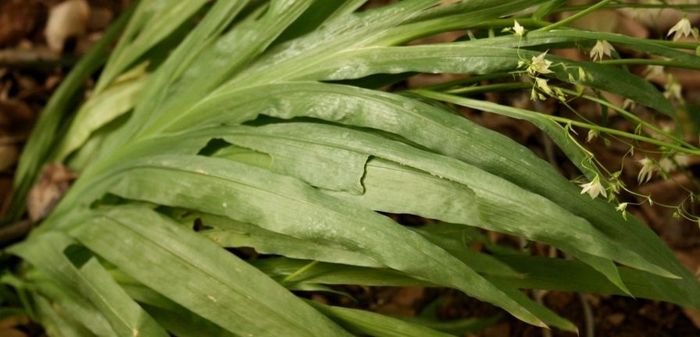
The soft, erect, sword-shaped leaves appear before the flowers.

Many small, delicate, star-like, cream-coloured to pale yellow flowers are sparsely arranged in a lax, branched spike on slender, wiry stems.
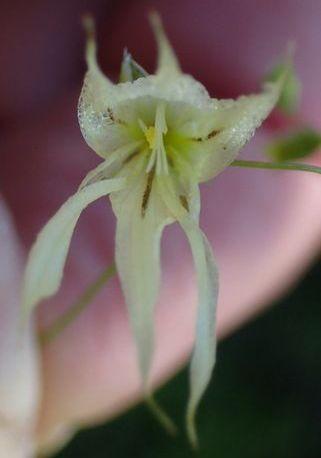
The flowers are zygomorphic, the lower tepals are streaked with red-brown in the midline and the flowers are sour smelling. Flowering occurs from winter to spring (June to September).
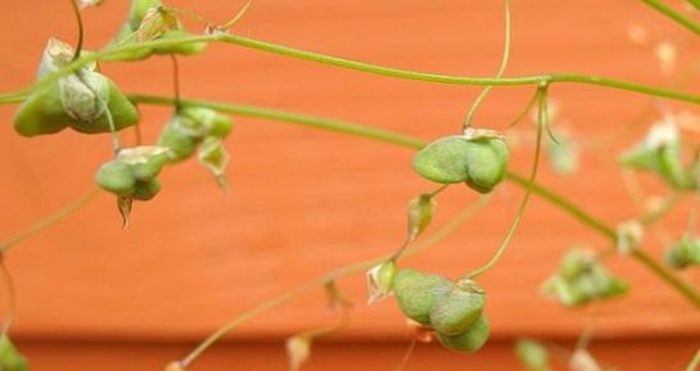
The fruit is a 3-winged loculicidal capsule.
Conservation Status
Status
This species is assessed as Least Concern (LC) according to SANBI`s Red List of South African plants. The population of the species is stable and is not endangered.
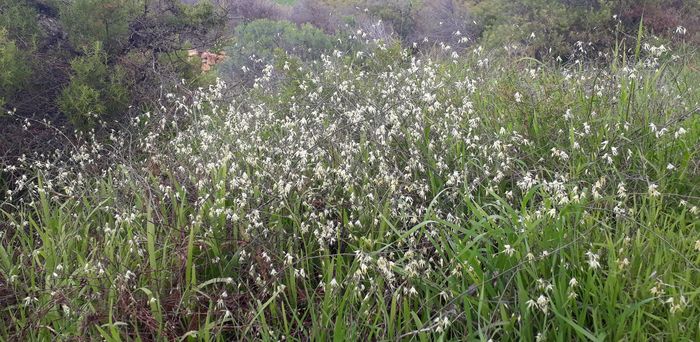
Distribution and habitat
Distribution description
Melasphaerula graminea is restricted to the winter rainfall region and occurs from southwestern Namibia to Agulhas, the Little Karoo and the Baviaanskloof Mountains in the Eastern Cape. It favours richer soils of clay and loam. It prefers to grow in sheltered localities, on sandstone or limestone usually favouring cool, southerly slopes or east-facing hillsides, in shady and moist places. The slender stems can also be found growing out above, and supported by, other bushes on the edge of scrub.

Derivation of name and historical aspects
History
The genus name Melasphaerula comes from the Greek melas, meaning ‘black’ and sphaerula, meaning ‘little ball’ referring to the plant’s small, black corms and cormlets. The specific epithet graminea, meaning ’grass-like’ refers to the nature of this plant; it is often mistaken for a kind of grass.
There is only a single known species of this genus. Melasphaerula graminea was first described in 1803. It was found by Thunberg, at the Cape of Good Hope, on the Groenekloof hills, and near Bergrivier, and introduced into Kew Gardens, by Mr Masson in 1787. The species was cultivated in England and Europe at one time.
Ecology
Ecology
The unpleasantly scented, sour and putrid odours emitted by the flowers, attract small March Flies (a nectar-feeding fly) which appear to be the only pollinators of these tiny, dull-coloured, short-tubed flowers. Ants are possibly responsible for the dispersal of the seeds. Melasphaerula graminea undergoes self-pollination (autogamy) in the absence of insect visitors. The plant loses its leaves in summer, this is an adaptation to cope with the seasonally dry and harsh summer conditions.

Uses
Use
There are no medicinal uses known for this plant. This plant is ideal for a hanging basket with its trailing sprays of pretty flowers. It will also do well in a shady rockery.
Growing Melasphaerula graminea
Grow
This plant prefers dappled shade but also performs well in morning sun. Melasphaerula graminea performs optimally in a well-aerated mixture of leaf mould or finely milled bark and coarse river-sand or industrial (silica) sand. In summer the growing medium should be kept dry. Regular drenching from autumn to early spring is required.
Sow seeds in autumn. In ideal conditions seedlings will easily flower in their second season.
Perform asexual propagation in late summer, separate the cormlets from the base of the mother corm and replant.
The partially self-fertile flowers set copious seeds and the species can become naturalised and invasive in ideal conditions. It is, therefore, best to contain the plant in a pot and keep it in check (Duncan, G. pers. comm. 2018).
Pests and diseases seldom attack the plants.
References
- Clarke, H. & Charters, M. 2016. The illustrated dictionary of southern African plant names. Flora & Fauna Publications Trust, Jacana, Johannesburg.
- Duncan, G. 2010. Grow bulbs. A guide to the cultivation of bulbs of South Africa and neighboring countries. Kirstenbosch Gardening Series. South African National Biodiversity Institute, Cape Town.
- Goldblatt, P. 2008. The iris family: natural history & classification. Timber Press, Portland.
- Golblatt, P., Manning, J.C. & Bernhardt, P. 2005. The floral biology of Melasphaerulea (Iridaceae: Crocoideae): is this monotypic genus pollinated by march flies (Diptera: Bibionidae)? Annals of the Missouri Botanical Garden 92(2): 268–274.
- Innes, C. 1985. The world of Iridaceae: a comprehensive record. Holly Gate International, Ashington.
- Le Roux, A. 2015. Wild flowers of Namaqualand. Struik Nature. Cape Town.
- Manning, J. 2003. Photographic guide to the wildflowers of South Africa. Briza Publications, Pretoria.
- Snijman, D.A. (ed.). 2013. Plants of the Greater Cape Floristic Region 2: The Extra Cape Flora. Strelitzia 30. South African National Biodiversity Institute, Pretoria.
- The American Iris Society, Iris Encyclopedia: Genus Melasphaerula. http://wiki.irises.org/Ird/IrdMelasphaerula. Accessed 29 October 2019.
Credits
Shireen Harris and Athi Sigcau
Karoo Desert National Botanical Garden
November 2019
Plant Attributes:
Plant Type: Bulb
SA Distribution: Eastern Cape, Northern Cape, Western Cape
Soil type: Sandy, Clay, Loam
Flowering season: Spring, Winter
PH: Acid, Alkaline
Flower colour: Cream
Aspect: Shade, Morning Sun (Semi Shade), Afternoon Sun (Semi Shade)
Gardening skill: Easy
Special Features:
Horticultural zones









Rate this article
Article well written and informative
Rate this plant
Is this an interesting plant?
Login to add your Comment
Back to topNot registered yet? Click here to register.